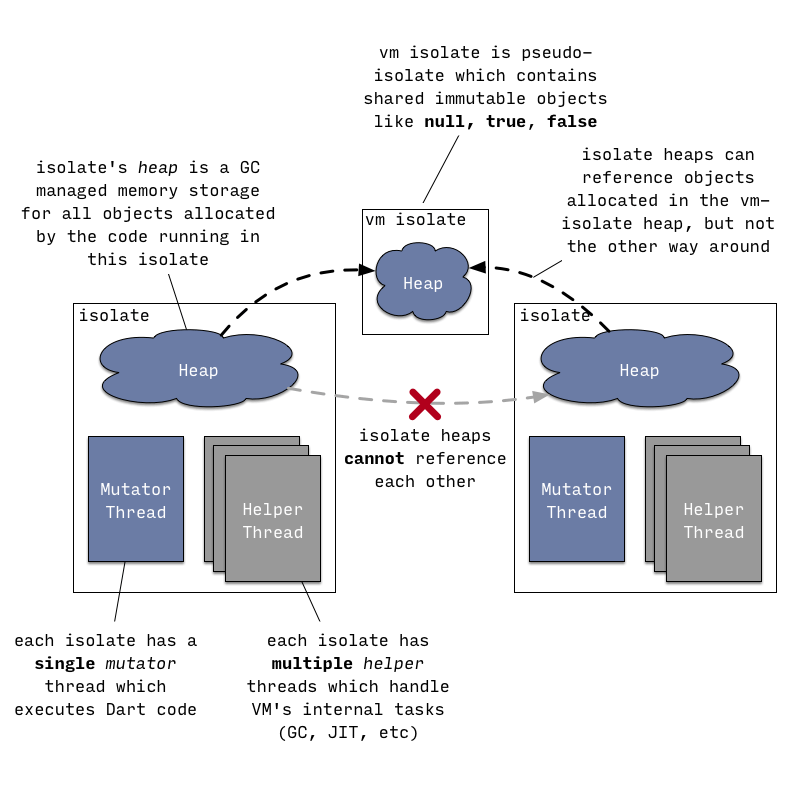Flutter Isolate线程分析
2019-07-16 小文字
在前面分析Isolate的使用过程中,我们掌握了几种使用Isolate的API,本文继续研究Isolate和线程的相关源码。
注意由于Flutter和Dart的版本不同,源码示意部分可能存在差异。 本文分析基于:Flutter Engine v1.78; Dart SDK v2.5
Flutter Engine
还记得前面提到过,Dart里面的Isolate和Process,Thread都有区别么?在开发中我们可以借助上面提到的使用compute来创建独立Isolate实现计算耗时任务,
这里有几个深入思考的问题:
- 创建Isolate是否可以复用?类似线程池?
- Isolate创建过多是否会有性能问题?
- 如果Isolate开销很大,是否实现一个Isolate对应多个任务,即一拖N的关系?
为了找到这些问题的答案,我先需要进一步去挖掘Isolate的实现源码。
Flutter SDK的源码由dart编写的,Engine部分是c++,在SDK层面关于线程和Isolate的相关代码通过简单索引只找到了一个定义位置:
external static Future<Isolate> spawn<T>(
void entryPoint(T message), T message,
{bool paused: false,
bool errorsAreFatal,
SendPort onExit,
SendPort onError,
@Since("2.3") String debugName});
他的定义是external也就是实现体在其他位置,不过通过检索整个flutter项目,并没有找到他的实现。因此我们把目光转到flutter engine项目。
为了方便分析,最好把engine的源码下载下来engine,时间会比较长。
git clone [email protected]:flutter/engine.git flutter-engine
/runtime/dart_isolate.h
// The root isolate of a Flutter application is special because it gets Window
// bindings. From the VM's perspective, this isolate is not special in any
// way.
static std::weak_ptr<DartIsolate> CreateRootIsolate(
const Settings& settings,
fml::RefPtr<const DartSnapshot> isolate_snapshot,
fml::RefPtr<const DartSnapshot> shared_snapshot,
TaskRunners task_runners,
std::unique_ptr<Window> window,
fml::WeakPtr<IOManager> io_manager,
fml::WeakPtr<ImageDecoder> image_decoder,
std::string advisory_script_uri,
std::string advisory_script_entrypoint,
Dart_IsolateFlags* flags,
fml::closure isolate_create_callback,
fml::closure isolate_shutdown_callback);
从实现体和注释信息,我们可以知道app启动后的默认root isolate关联了很多模块,比如task runners,IO manager,Image Decoder
/runtime/dart_isolate.cc
// Since this is the root isolate, we fake a parent embedder data object. We
// cannot use unique_ptr here because the destructor is private (since the
// isolate lifecycle is entirely managed by the VM).
//
// The child isolate preparer is null but will be set when the isolate is
// being prepared to run.
auto root_embedder_data = std::make_unique<std::shared_ptr<DartIsolate>>(
std::make_shared<DartIsolate>(
settings, // settings
std::move(isolate_snapshot), // isolate snapshot
std::move(shared_snapshot), // shared snapshot
task_runners, // task runners
std::move(io_manager), // IO manager
std::move(image_decoder), // Image Decoder
advisory_script_uri, // advisory URI
advisory_script_entrypoint, // advisory entrypoint
nullptr, // child isolate preparer
isolate_create_callback, // isolate create callback
isolate_shutdown_callback // isolate shutdown callback
));
关于Runner,实际上开发Flutter的时候并不会直接使用到,他更多的是Flutter Framework内部的模块划分,具体runner:
- platform runner
- gpu runner
- ui runner
- io runner
common/task_runners.cc
TaskRunners::TaskRunners(std::string label,
fml::RefPtr<fml::TaskRunner> platform,
fml::RefPtr<fml::TaskRunner> gpu,
fml::RefPtr<fml::TaskRunner> ui,
fml::RefPtr<fml::TaskRunner> io)
: label_(std::move(label)),
platform_(std::move(platform)),
gpu_(std::move(gpu)),
ui_(std::move(ui)),
io_(std::move(io)) {}
shell/common/thread_host.cc
每一个Runner对应一个独立的线程,线程名字均带有各自的后缀
ThreadHost::ThreadHost(std::string name_prefix, uint64_t mask) {
if (mask & ThreadHost::Type::Platform) {
platform_thread = std::make_unique<fml::Thread>(name_prefix + ".platform");
}
if (mask & ThreadHost::Type::UI) {
ui_thread = std::make_unique<fml::Thread>(name_prefix + ".ui");
}
if (mask & ThreadHost::Type::GPU) {
gpu_thread = std::make_unique<fml::Thread>(name_prefix + ".gpu");
}
if (mask & ThreadHost::Type::IO) {
io_thread = std::make_unique<fml::Thread>(name_prefix + ".io");
}
}
void ThreadHost::Reset() {
platform_thread.reset();
ui_thread.reset();
gpu_thread.reset();
io_thread.reset();
}
Dart VM
Android有Dalvik, ART,Java有JVM。Flutter也有Dart VM,他包含了执行dart所必须的整套环境,具体包括:
1. Runtime System 运行时系统
* Object Model 对象模型
* Garbage Collection 垃圾回收
* Snapshots 快照
2. Core libraries native methods 核心库,native方法
3. Development Experience components accessible via service protocol 开发协议
* Debugging 调试
* Profiling 调优
* Hot-reload 热更新
4. Just-in-Time (JIT) and Ahead-of-Time (AOT) compilation pipelines 变量管道JIT和AOT
5. Interpreter 解释器
6. ARM simulators ARM模拟器
针对Flutter来说,代码经过编译为机器码后在壳应用中运行,发布模式下使用的是AOT+Runtime,开发期间使用的是JIT+VM。
Isolate中代码执行和内存情况,可以参考下图。

下面分析下Isolate的执行线程问题,相关源码位置在runtime/vm/isolate.cc内。
一个Isolate的初始化,包括heap的创建,运行线程设置,线程异常配置等。 当Isolate运行时,他确实是跑在一个线程上面的。Isolate运行后,调用了消息处理器的Run方法,同时传入了线程池。
void Isolate::Run() {
message_handler()->Run(Dart::thread_pool(), RunIsolate, ShutdownIsolate,
reinterpret_cast<uword>(this));
}
在消息处理器内部,会将MessageHandlerTask丢到线程池内执行。
runtime/vm/message_handler.cc
void MessageHandler::Run(ThreadPool* pool,
StartCallback start_callback,
EndCallback end_callback,
CallbackData data) {
bool task_running;
MonitorLocker ml(&monitor_);
if (FLAG_trace_isolates) {
OS::PrintErr(
"[+] Starting message handler:\n"
"\thandler: %s\n",
name());
}
ASSERT(pool_ == NULL);
ASSERT(!delete_me_);
pool_ = pool;
start_callback_ = start_callback;
end_callback_ = end_callback;
callback_data_ = data;
task_ = new MessageHandlerTask(this);
task_running = pool_->Run(task_);
ASSERT(task_running);
}
class MessageHandlerTask : public ThreadPool::Task {
public:
explicit MessageHandlerTask(MessageHandler* handler) : handler_(handler) {
ASSERT(handler != NULL);
}
virtual void Run() {
ASSERT(handler_ != NULL);
handler_->TaskCallback();
}
private:
MessageHandler* handler_;
DISALLOW_COPY_AND_ASSIGN(MessageHandlerTask);
};
最终执行了Isolate的入口函数,如main函数
if (start_callback_) {
// Initialize the message handler by running its start function,
// if we have one. For an isolate, this will run the isolate's
// main() function.
//
// Release the monitor_ temporarily while we call the start callback.
ml.Exit();
status = start_callback_(callback_data_);
ASSERT(Isolate::Current() == NULL);
start_callback_ = NULL;
ml.Enter();
}
Isolate与线程调度问题
现在我们回顾下前面提出的疑问
创建Isolate是否可以复用?类似线程池?
Isolate本身并不是和线程样一一对应,Isolate运行在一个线程上,同时线程是通过线程池进行的复用,创建Isolate可以不用考虑复用线程问题。但是Isolate本身会开辟内存栈,因此过多的Isolate可预见的,对内存会有更多要求。
Isolate创建过多是否会有性能问题?
理论上会影响性能,这个具体影响,可以通过实验来验证,创建一个Isolate所消耗的内存资源。 我们编写一段代码,循环10次创建10个Isolate,观察内存情况,可以得到下面两张图


平均新建一个Isolate的内存开销为(332-71.5)/10MB = 26MB
当我们结束这些新建的Isolate后,内存基本全部释放,配合一次GC,内存降到了64MB

如果Isolate开销很大,是否实现一个Isolate对应多个任务,即一拖N的关系?
如果要实现一拖N的关系,那么不能使用compute封装的API,我们需要维护并复用一个Isolate,因此每个任务结束后不能直接kill掉Isolate。